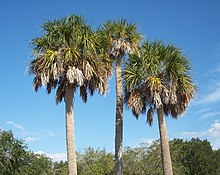Sabal palmetto
| Cabbage-palm | |
|---|---|
 |
|
| Sabal palmetto in habitat, Florida | |
| Scientific classification | |
| Kingdom: | Plantae |
| (unranked): | Angiosperms |
| (unranked): | Monocots |
| (unranked): | Commelinids |
| Order: | Arecales |
| Family: | Arecaceae |
| Subfamily: | Coryphoideae |
| Tribe: | Sabaleae |
| Genus: | Sabal |
| Species: | S. palmetto |
| Binomial name | |
|
Sabal palmetto (Walt.) Lodd. |
|
| Synonyms | |
|
Synonymy
|
|
Sabal palmetto, also known as cabbage-palm,palmetto, cabbage palmetto,blue palmetto,Carolina palmetto,common palmetto,swamp cabbage and sabal palm, is one of 15 species of palmetto palm. It is native to the deep southern United States, as well as Cuba, the Turks & Caicos Islands, and The Bahamas.
In the United States the native range of Sabal palmetto is the coastal plain of the lower East Coast from southeast North Carolina southward to Florida and west along the Gulf Coastal plain to Texas.
Sabal palmetto grows up to 65 feet or 20 metres. Starting at ½ to ⅔ the height the tree develops into a rounded, costapalmate fan of numerous leaflets. A costapalmate leaf has a definite costa (midrib) unlike the typical palmate or fan leaf, but the leaflets are arranged radially like in a palmate leaf. All costapalmate leaves are about 0.20 inches or 5.1 millimetres across, produced in large compound panicles up to 8.2 feet or 2.5 metres in radius, extending out beyond the leaves. The fruit is a black drupe about .5 inches or 1.3 centimetres long containing a single seed. It is extremely salt-tolerant and is often seen growing near both the Atlantic Ocean coast and the Gulf of Mexico coast.
Sabal palmetto is hardy to USDA zone 8, and has been reported to have some cold hardness down to −13 °C or 8.6 °F. Maintenance of the Cabbage Palm tree is very easy and very adaptable. The cabbage palmetto is known to tolerate drought, standing water and brackish water. Even though this palm is drought-tolerant, it thrives on regular light watering and regular feeding. It is highly tolerant of salt winds, but not saltwater flooding.
The cabbage-like terminal bud has been eaten as hearts of palm. The bristles on the sheaths of young leaves have been made into scrubbing brushes. The trunks have been used as wharf piles. On June 28, 1776, Charleston patriots under George Washington made a fort of palmetto trunks and from it defended successfully against the British in the Revolutionary War.
...
Wikipedia

